Friction -types of friction and dry friction
- 1. Ch. 4: Friction 4.0 Outline 203 ’ü« Introduction 204 ’ü« Types of Friction 205 ’ü« Dry Friction 206 4.0 Outline 203
- 2. Ch. 4: Friction 4.1 Introduction 4.1 Introduction In real situation, the forces of action and reaction between contacting surfaces have their components both in the tangential and normal directions to the contacting surface. Tangential forces are known as Friction forces. Whenever a tendency exists for one contacting surface to slide along another surface, the friction forces developed are always in a direction to oppose this tendency. In some systems, friction is undesirable since it normally spoils the required behavior. But in many situations, friction functions the systems. In real case where sliding motion between parts occurs, the friction forces result in a loss of energy. 204
- 3. Ch. 4: Friction 4.2 Types of Friction 4.2 Types of Friction a) Dry (Coulomb) friction when unlubricated surfaces are in contact under a condition of sliding or tendency to slide. Friction force tangent to the surfaces of contact is developed both during the interval leading up to impending slippage and while slippage takes place. Its direction always opposes the motion or impending motion which would occur if no friction were present. b) Fluid friction c) Internal friction 205
- 4. Ch. 4: Friction 4.3 Dry Friction 4.3 Dry Friction Mechanism of friction 206
- 5. Ch. 4: Friction max F F < max s F F N ┬Ą = = 4.3 Dry Friction Three regions of static ’āĀ motion transition a) No motion is the region up to the point of slippage or impending motion. Friction force is determined by the equations of equilibrium because the system is in equilibrium. When the motion is not impending, b) Impending motion is the moment where the body is on the verge of slipping. Static friction force reaches the max value. For a given pair of mating surfaces, . c) Motion The body starts moving in the direction of the applied force. Here, friction force drops to a lower value called kinetic friction . It will drop further with higher velocity. k F N ┬Ą = 207
- 6. Ch. 4: Friction tan F/N ╬▒ = s s tanŽå ┬Ą = k k tanŽå ┬Ą = 4.3 Dry Friction Friction cone Friction coefficient reflects the roughness of a pair of mating surfaces. The smaller the coefficient value, the smoother the surfaces. Direction of resultant R is specified by . When the friction force reaches max value, . When slippage occurs, . The friction angle defines the limiting position of the total reaction force R. The friction cone of vertex angle represents the locus of possible positions for the reaction force R. Friction force is independent of the apparent or projected area of contact. s k , Žå Žå s k 2 , 2 Žå Žå 208
- 7. Ch. 4: Friction 4.3 Dry Friction Friction cone 209
- 8. Ch. 4: Friction s F N ┬Ą = 4.3 Dry Friction Types of dry friction problems First step is to identify which of these categories applies. 1) Condition of impending motion is known to exist The body is in equilibrium and on the verge of slipping. Friction force is the max static friction 2) Relative motion is known to exist Friction force is the kinetic friction 3) Unknown status of the problem Assume static equilibrium and solve for the required friction force F. Then check and conclude the status. k F N ┬Ą = 210
- 9. Ch. 4: Friction s N ┬Ą s F N ┬Ą > s F N ┬Ą = 4.3 Dry Friction Possible outcomes a) friction force for the assumed equilibrium can be provided and so the body is in static equilibrium. b) max friction force is required for the static equilibrium condition and so motion impends. c) surfaces cannot support more friction than . So the equilibrium assumption is invalid and motion occurs instead. Friction force is the kinetic friction . Even with the correct kinetic friction substituted, equilibrium equations are still not hold ’āĀ accelerated motion s F N ┬Ą < k F N ┬Ą = 211
- 10. Ch. 4: Friction 4.3 Dry Friction P. 4/1 Determine the max angle ╬Ėwhich the adjustable incline may have with the horizontal before the block of mass m begins to slip. The coefficient of static friction between the block and the inclined surface is ╬╝s. 212
- 11. Ch. 4: Friction y x s 1 s s F 0 N mgcos 0 F 0 N mgsin 0 tan or tan ╬Ė ┬Ą ╬Ė ┬Ą ╬Ė ╬Ė ┬Ą ŌłÆ ’Ż« ’Ż╣ = ŌłÆ = ’Ż░ ’Ż╗ ’Ż« ’Ż╣ = ŌłÆ = ’Ż░ ’Ż╗ = = Ōłæ Ōłæ 4.3 Dry Friction P. 4/1 at the moment of slipping, friction is upward s F N ┬Ą = when the friction force reaches max value, s s tanŽå ┬Ą = by equilibrium, R = W and s Žå ╬Ė = 1 s tan ╬Ė ┬Ą ŌłÆ Ōł┤ = s Žå R 213
- 12. Ch. 4: Friction 4.3 Dry Friction P. 4/2 Determine the range of values which the mass mo may have so that the 100 kg block shown in the figure will neither start moving up the plane nor slip down the plane. The coefficient of static friction for the contact surface is 0.30. 214
- 13. Ch. 4: Friction y F 0 N 100gcos20 0, N 922 N ’Ż« ’Ż╣ = ŌłÆ = = ’Ż░ ’Ż╗ Ōłæ 4.3 Dry Friction P. 4/2 bounded mo values ’āĀ block start moving ’āĀ Case I: max mo, start moving up, friction downward Case II: min mo, start moving down, friction upward s F N ┬Ą = x o s o F 0 m g N 100gsin20 0, m 62.4 kg ┬Ą ’Ż« ’Ż╣ = ŌłÆ ŌłÆ = = ’Ż░ ’Ż╗ Ōłæ x o s o o max F 0 m g N 100gsin20 0, m 6.0 kg 6.0 m 62.4 kg and F F 277 N up/downward ┬Ą ’Ż« ’Ż╣ = + ŌłÆ = = ’Ż░ ’Ż╗ Ōł┤ Ōēż Ōēż Ōēż = Ōłæ 215
- 14. Ch. 4: Friction 4.3 Dry Friction P. 4/3 Determine the magnitude and direction of the friction force acting on the 100 kg block shown if, first, P = 500 N and, second, P = 100 N. The coefficient of static friction is 0.20, and the coefficient of kinetic friction is 0.17. The force are applied with the block initially at rest. 216
- 15. Ch. 4: Friction y s x s F 0 N 500sin 20 100gcos20 0, N 1092.85 N max supportable friction N 218.6 N F 0 500cos20 F 100gsin20 0, F 134.3 N N the assumption is valid ┬Ą ┬Ą ’Ż« ’Ż╣ = ŌłÆ ŌłÆ = = ’Ż░ ’Ż╗ = = ’Ż« ’Ż╣ = ŌłÆ ŌłÆ = = < ’Ż░ ’Ż╗ Ōł┤ Ōłæ Ōłæ 4.3 Dry Friction P. 4/3 donŌĆÖt know if the block is impending or is moving ’āĀ assume static equilibrium P = 500 N: assume the block tends to move up ’āĀ friction downward P = 100 N: assume the block tends to slide down ’āĀ friction upward y s x s F 0 N 100sin 20 100gcos20 0, N 956.04 N max supportable friction N 191.21 N F 0 F 100cos20 100gsin20 0, F 241.55 N N the assumption is invalid, block is moving downward kinetic f ┬Ą ┬Ą ’Ż« ’Ż╣ = ŌłÆ ŌłÆ = = ’Ż░ ’Ż╗ = = ’Ż« ’Ż╣ = + ŌłÆ = = > ’Ż░ ’Ż╗ Ōł┤ Ōłæ Ōłæ k riction upward N 162.5 N ┬Ą = = 217
- 16. Ch. 4: Friction 4.3 Dry Friction P. 4/4 The homogeneous rectangular block of mass m, width b, and height H is placed on the horizontal surface and subjected to a horizontal force P which moves the block along the surface with a constant velocity. The coefficient of kinetic friction between the block and the surface is ╬╝k. Determine (a) the greatest value that h may have so that the block will slide without tipping over and (b) the location of a point C on the bottom face of the block through which the resultant of the friction and normal forces acts if h = H/2. 218
- 17. Ch. 4: Friction k tan╬Ė ┬Ą = 4.3 Dry Friction P. 4/4 a) On the verge of tipping over, reaction acts at the corner A When slippage occurs, Block moves w/ const. velocity ’āĀ equilibrium Three-force member: reaction at A must pass through B ( ) k k tan b/2h, h b/ 2 ╬Ė ┬Ą ┬Ą = = Ōł┤ = b) When slippage occurs, Block moves w/ const. velocity ’āĀ equilibrium Three-force member: reaction at C must pass through G k tan╬Ė ┬Ą = ( ) k k tan x/ H/2 , x H/2 ╬Ė ┬Ą ┬Ą = = Ōł┤ = 219
- 18. Ch. 4: Friction 4.3 Dry Friction P. 4/5 The three flat blocks are positioned on the 30┬░incline as shown, and a force P parallel to the incline is applied to the middle block. The upper block is prevented from moving by a wire which attaches it to the fixed support. The coefficient of static friction for each of the three pairs of mating surfaces is shown. Determine the maximum value which P may have before any slipping takes place. 220
- 19. Ch. 4: Friction 4.3 Dry Friction P. 4/5 221
- 20. Ch. 4: Friction y 1 1 2 1 2 3 2 3 F 0 N 30gcos30 0, N 254.87 N N N 50gcos30 0, N 679.66 N N N 40gcos30 0, N 1019.5 N ’Ż« ’Ż╣ = ŌłÆ = = ’Ż░ ’Ż╗ ŌłÆ ŌłÆ = = ŌłÆ ŌłÆ = = Ōłæ 1 s 1 2 s 2 3max s 3 2 3 3 3max F N 76.46 N, F N 271.86 N F N 458.8 N block #3: F F 40gsin30 0, F 468.06 N F block #3 cannot stay still -- the assumption is invalid ┬Ą ┬Ą ┬Ą = = = = = = ŌłÆ + = = > Ōł┤ 4.3 Dry Friction P. 4/5 Since 30 kg-block cannot slide and 50 kg-block is pulled, 50 kg-block tends to move and only 2 cases are possible. Either 50 kg-block alone or 50&40 kg-blocks move together. 50 kg-block tends to move alone ’āĀ F1 & F2 max (either one alone will not slip) 50&40 kg-blocks tend to move together ’āĀ F1 & F3 max (either one alone will not slip) 2 3 2 2max 1 2 block #3: F F 40gsin30 0, F 262.6 N F block #2 & #3 does not slip relative to each other block #2: P F F 50gsin30 0, P 93.8 N ŌłÆ + = = < Ōł┤ ŌłÆ ŌłÆ + = = 222
- 21. Ch. 4: Friction 4.3 Dry Friction P. 4/6 The light bar is used to support the 50 kg block in its vertical guides. If the coefficient of static friction is 0.30 at the upper and 0.40 at the lower end of the bar, find the friction force acting at each end for x = 75 mm. Also find the maximum value of x for which the bar will not slip. 223
- 22. Ch. 4: Friction 1 1 A B tan 21.8 , tan 16.7 Žå ┬Ą Žå ┬Ą ŌłÆ ŌłÆ = = ┬░ = = ┬░ ( ) 1 B A sin 75/300 14.5 ╬Ė Žå Žå ŌłÆ = = ┬░ < < 4.3 Dry Friction P. 4/6 Bar is a two-force member. Assume the system is in equilibrium. Hence the reaction forces at both ends act along the axial direction. at x = 75 mm: limitation of the reaction force on each end y R inside the static friction cone, system is in equilibrium and F Ntan 126.6 N ╬Ė = = y F 0 N 50g 0, N 490.5 N ’Ż« ’Ż╣ = ŌłÆ = = ’Ż░ ’Ż╗ Ōłæ max x before slipping when the bar angle = that of small friction cone B x/300 sin , x 86.2 mm Žå = = R R N N F F 224
- 23. Ch. 4: Friction 4.3 Dry Friction P. 4/7 Find the tension in the cable and force P that makes the 15 kg lower block (a) to start sliding downward (b) to start sliding upward 225
- 24. Ch. 4: Friction 1 2 1 2 1max 1 2max 2 N 8gcos20 73.75 N N N 15gcos20 0, N 212 N F 0.3N 22.12 N F 0.4N 84.81 N = = ŌłÆ ŌłÆ = = = = = = 1max 2max 1max P F F 15gsin20 0, P 56.6 N F 8gsin20 T 0, T 49 N ŌłÆ ŌłÆ + = = + ŌłÆ= = 4.3 Dry Friction P. 4/7 a) pulling down, 15 kg block impends to slide downward 15g 8g F1 F1 N1 N1 T P F2 N2 226
- 25. Ch. 4: Friction 1 2 1 2 1max 1 2max 2 N 8gcos20 73.75 N N N 15gcos20 0, N 212 N F 0.3N 22.12 N F 0.4N 84.81 N = = ŌłÆ ŌłÆ = = = = = = 4.3 Dry Friction P. 4/7 b) pushing up, assume 15&8 kg blocks impends to slide upward together the cable slacks ’āĀ T=0 1 1 1max 1max 2max 1max 8 kg block: 8gsin20 F 0, F 26.84 N F 15 kg block impends to slide upward alone P F F 15gsin20 0, P 157.3 N T F 8gsin20 0, T 4.72 N ŌłÆ = = > Ōł┤ ŌłÆ + + + = = ŌłÆ ŌłÆ + = = 15g 8g F1 F1 N1 N1 T P F2 N2 227
- 26. Ch. 4: Friction 4.3 Dry Friction P. 4/8 The uniform slender rod of mass m and length L is initially at rest in a centered horizontal position on the fixed circular surface of radius R = 0.6L. If a force P normal to the bar is gradually applied to its end until the bar begins to slip at the angle ╬Ė= 20┬░, determine the coefficient of static friction. 228
- 27. Ch. 4: Friction [ ] a/r a 20 R R/9 180 ŽĆ ╬Ė ŽĆ ’Ż½ ’ŻČ = = = ’Ż¼ ’ŻĘ ’ŻŁ ’ŻĖ ’ü¦ 4.3 Dry Friction P. 4/8 no slip until ╬Ė=20┬░’āĀ distance on bar = length on curve ( ) ( ) s L/2 R/9 tan F/N 0.211 L/ 2tan20 ŽĆ ┬Ą ╬▒ ŌłÆ = = = = 20┬░ L/(2tan20) ╬▒ ╬▒ 229
- 28. Ch. 4: Friction 4.3 Dry Friction P. 4/9 The three identical rollers are stacked on a horizontal surface as shown. If the coefficient of static friction ╬╝s is the same for all pairs of contacting surfaces, find the minimum value of ╬╝s for which the rollers will not slip. 230
- 29. Ch. 4: Friction O A B A B Amax Bmax A B A Amax B M 0 F F from the figure, N N F F so F reaches the limit value before F slipping does occur first at contact A F F and F determined by equilibrium equation ’Ż« ’Ż╣ = = ’Ż░ ’Ż╗ < Ōł┤ < Ōł┤ Ōł┤ = Ōłæ 4.3 Dry Friction P. 4/9 lower roller: three-force member reaction force at A must pass through contact B from geometry, Lower roller tends rolling out at upper contact while tends to slide out at lower contact condition: one or more contacts impend to slip FBD: lower left roller (three-force member) Amax s F F , tan tan15 0.268 ╬▒ ┬Ą = Ōł┤ = = = ’üæ A B NB NA FA FB mg O R ╬▒ 30┬░ 15┬░ r r A B O 231
- 30. Ch. 4: Friction 4.3 Dry Friction P. 4/10 The industrial truck is used to move the solid 1200 kg roll of paper up the 30┬░incline. If the coefficients of static and kinetic friction between the roll and the vertical barrier of the truck and between the roll and the incline are both 0.40, compute the required tractive force P between the tires of the truck and the horizontal surface. 232
- 31. Ch. 4: Friction 4.3 Dry Friction P. 4/10 To move the paper roll, 3 possibilities 1) A and B both slip 2) only B slips 3) only A slips after calculation, only case 3) is viable A O B A x A B B B A y A B B A B B B slipping at A, F 0.4N M 0 F 0.4N F 0 N F cos30 N sin30 0, N 1.307N F 0 0.4N 1200g F sin30 N cos30 0 N 22.1 kN, N 28.9 kN, F 8853 N 0.4N = ’Ż« ’Ż╣ = = ’Ż░ ’Ż╗ ’Ż« ’Ż╣ = ŌłÆ ŌłÆ = = ’Ż░ ’Ż╗ ’Ż« ’Ż╣ = ŌłÆ ŌłÆ ŌłÆ + = ’Ż░ ’Ż╗ = = = < Ōłæ Ōłæ Ōłæ A O B NB FB NA 0.4NA 1200g 233








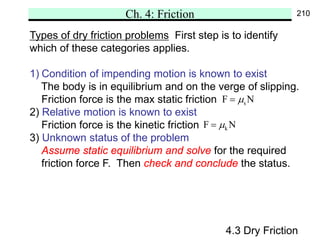
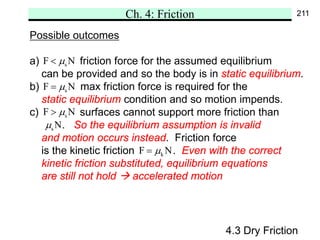
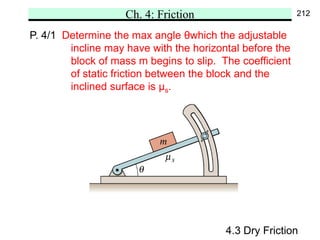
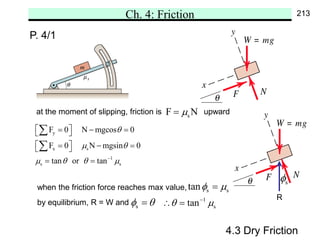


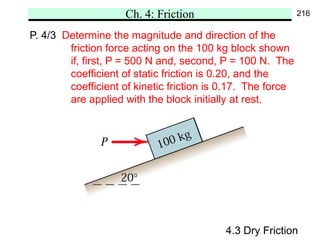

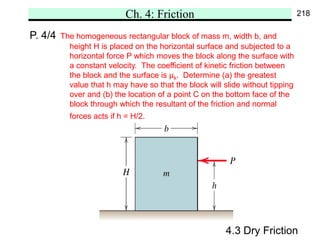

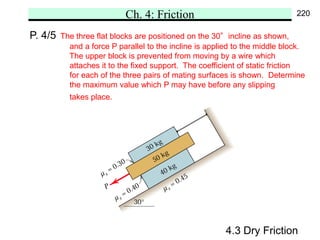

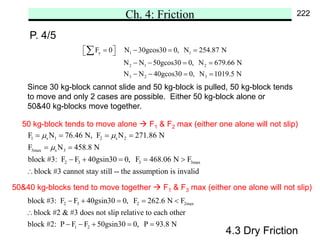






![Ch. 4: Friction
[ ]
a/r a 20 R R/9
180
ŽĆ
╬Ė ŽĆ
’Ż½ ’ŻČ
= = =
’Ż¼ ’ŻĘ
’ŻŁ ’ŻĖ
’ü¦
4.3 Dry Friction
P. 4/8
no slip until ╬Ė=20┬░’āĀ
distance on bar = length on curve
( )
( )
s
L/2 R/9
tan F/N 0.211
L/ 2tan20
ŽĆ
┬Ą ╬▒
ŌłÆ
= = = =
20┬░
L/(2tan20)
╬▒
╬▒
229](https://image.slidesharecdn.com/ch4-241222164653-d96b388e/85/Friction-types-of-friction-and-dry-friction-27-320.jpg)



